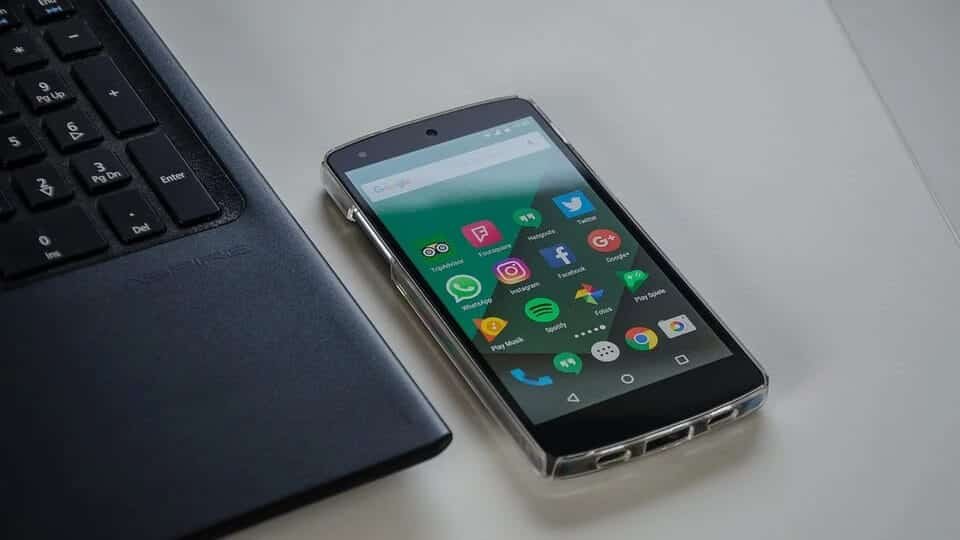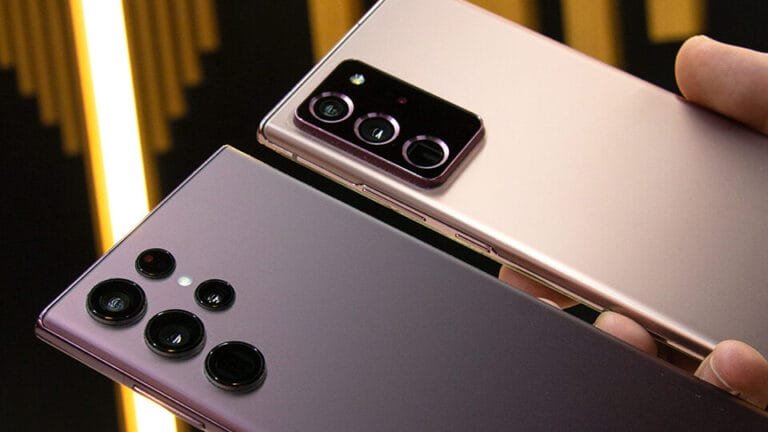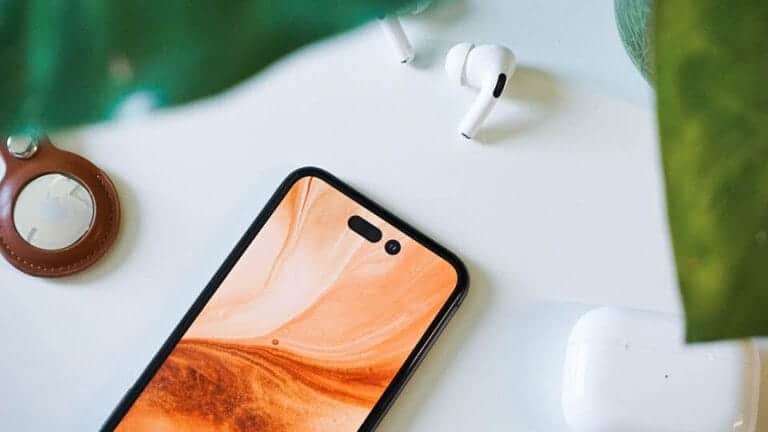17 best smartphones with powerful processors in 2023

If you are faced with choosing a new smartphone, pay attention not only to its appearance, but also to its technical characteristics. The greatest attention should be paid to the processor on which the device was designed.
The processor is the heart of a smartphone, its most important component, it is responsible for all calculations, works with memory, graphics chip, the speed and smoothness of the interface, the quality of photo and video shooting depend on its power. In addition, the information coming from the camera module is also processed by the processor.
When choosing a processor, you need to consider your needs. If a person plays, he will be more comfortable with the device in which the flagship solution is installed. For example, for Apple it will be the iPhone 13 on the A15 Bionic chip – this is the most productive solution that can be found in a mobile device at the moment. If the choice is in favor of a smartphone running Android OS, you should take a closer look at a device based on processors such as Qualcomm Snapdragon 888+ and Qualcomm Snapdragon 888.
Perhaps the buyer does not play, and his priorities are shifted towards a high-quality screen, good cameras and long battery life. In this case, you can pay attention to the flagship devices of previous years or smartphones in the mid-price segment, which maintain a balance of power and performance.
Editor’s Choice
iPhone 13

The iPhone 13 has Apple’s most powerful processor designed specifically for smartphones. Apple A15 Bionic surpasses all its competitors in power and energy efficiency; it ensures smooth operation of the interface, processing of photos and videos that the user receives from the device’s cameras.
In addition, this is a compact smartphone with a 6.1-inch display diagonal, the back panel is made of tempered glass, and the frame framing the device is made of aluminum, this gives a sense of solidity to the entire structure. Thanks to a modern processor and fast RAM, this phone will delight its owner for many years.
Main characteristics
| Screen | 6.1″ (2532×1170), Full HD, OLED |
| CPU | Apple A15 Bionic |
| Built-in memory | 128/256/512 GB |
| RAM | 4 GB |
| Main cameras | wide-angle 12 MP F/1.60, ultra-wide-angle 12 MP F/2.40 |
| Front-camera | 12 MP |
Top 16 best smartphones with powerful processor in 2023
ASUS ROG Phone 5s

An uncompromising solution for gamers, it is powered by the most powerful Qualcomm Snapdragon 888+ processor, which has increased performance with a frequency of up to 3 GHz on the most powerful cores. The user will be able to play at maximum settings, enjoying graphics on a large display with a refresh rate of 144 Hz, which ensures smooth images.
The manufacturer focused on the gaming component, but did not forget about photo and video capabilities: the main camera has a resolution of 64 megapixels and high-aperture optics with optical stabilization, thanks to which the photos will be clear and the video smooth. In addition, the smartphone has a powerful 6000 mAh battery with fast charging capabilities.
Main characteristics
| Screen | 6.78″ (2448×1080), Full HD, AMOLED |
| CPU | Qualcomm Snapdragon 888+ |
| Built-in memory | 512 GB |
| RAM | 16 GB |
| Main cameras | wide-angle 64 MP F/1.80, ultra-wide-angle 13 MP F/2.40, macro 5 MP F/2 |
| Front-camera | 24 MP |
OnePlus 10 Pro

One of the most functional smartphones today. The phone received the new generation flagship hardware platform Qualcomm Snapdragon 8 Gen 1, which increased performance and helped reduce the heating of the device. The phone looks simple and aesthetically pleasing, and due to the ergonomic curves of the screen towards the sides, the smartphone seems more compact than it actually is.
The 6.7-inch display, a screen with excellent brightness, color reproduction and support for adapting the refresh rate up to 120 Hz in automatic mode, will allow you to enjoy realistic and rich images when playing the most demanding games with high frame rates.
In addition, this phone boasts a cool camera unit, which consists of three modules. The main camera has an exclusive sensor with a resolution of 48 megapixels, which is equipped with hybrid autofocus, optical stabilization and f1.8 aperture. The second camera has a resolution of 50 megapixels, an extreme viewing angle of 150 degrees and an 8 megapixel telephoto lens with 3.3x optical zoom.
The battery life with average screen brightness and active use of the smartphone will be 13 hours.
Main characteristics
| Screen | 6.7″ (3216×1440), AMOLED, 120 Hz |
| CPU | Qualcomm Snapdragon 8 Gen1 |
| Built-in memory | 128/256/512 GB |
| RAM | 8/12 GB |
| Main cameras | wide-angle 48 MP F/1.80, ultra-wide-angle 50 MP F/2.20, telephoto 8 MP 3x F/2.40 |
| Front-camera | 32 MP with optical stabilization |
Huawei P50 PRO

This time, Huawei is releasing its flagship not with a proprietary processor, but with a Qualcomm Snapdragon 888, but without support for 5G networks. When designing this smartphone, emphasis was placed on the capabilities of the camera and its performance in various use scenarios.
The 50 megapixel main camera with auto focus allows you to take clear and bright photos. In addition, the curved display of the smartphone has a diagonal of 6.6 inches and an adaptive refresh rate of 120 Hertz, a capacious 4360 mAh battery and 65 watt fast charging.
Main characteristics
| Screen | 6.6″ (2700×1228), Full HD, OLED |
| CPU | Qualcomm Snapdragon 888 4G, 2840 MHz |
| Built-in memory | 128/256/512 GB |
| RAM | 8/12 GB |
| Main cameras | 50 MP F/1.80, 40 MP F/1.60, ultra-wide-angle 13 MP F/2.20, telephoto 64 MP F/3.50 |
| Front-camera | 13 MP |
Sony Xperia 1III

The flagship device from Sony, powered by Qualcomm Snapdragon 888, one of the best processors ever installed in smartphones. In the Sony Xperia 1 III, the emphasis was placed on the photo and video capabilities of the device. Three main cameras, each with a resolution of 12 megapixels, but different focal lengths and light sensitivity.
In photo mode, optical stabilization is available on each lens, constantly focusing on moving objects. When shooting a video, with just one click on the screen, you can set professional camera settings, thanks to which the video will look like a scene from a movie.
In addition to powerful cameras, the smartphone has an HDR OLED 4K display with an adaptive refresh rate of 120 Hz and an aspect ratio of 21:9. This aspect ratio makes the device narrow enough and comfortable to use with one hand. The phone is protected from water and dust according to the IP65/68 standard, and a capacious 4500 mAh battery is responsible for the autonomy of the device.
Main characteristics
| Screen | 6.5 inches 21:9 HDR OLED 4K (3840×1644) |
| CPU | Qualcomm Snapdragon 888 |
| Built-in memory | 256 GB |
| RAM | 12 GB |
| Main cameras | 3 cameras with a resolution of 12 MP |
| Front-camera | 8 MP |
Samsung Galaxy s22

One of the flagships of the Korean company, which runs on the proprietary Samsung Exynos 2200 processor, amazes with its performance and energy efficiency. The phone copes with all tasks that the user can assign to it – from long photo and video shooting to an intense gaming session. Fast, the most compact of all produced models, a lightweight device, with a camera for amateurs and professionals, with which you can capture the brightest moments of your life and even edit them into a movie in 8K resolution.
The main 50 megapixel camera with autofocus and optical image stabilization will make video recording smooth and photos bright in any lighting conditions. The second camera with optical zoom allows you to get closer to your subjects without losing image clarity. The device is powered by a 3700 mAh battery, which affects the battery life; with standard use, the charge lasts for 7 hours.
Main characteristics
| Screen | 6.1″ (2340×1080), Dynamic AMOLED |
| CPU | Samsung Exynos 2200 |
| Built-in memory | 128/256 GB |
| RAM | 8 GB |
| Main cameras | wide-angle 50 MP 3x F/1.80, ultra-wide-angle 12 MP F/2.20, telephoto 10 MP F/2.40 |
| Front-camera | 10 MP |
Xiaomi 12 Pro

Xiaomi 12 Pro is another smartphone that is powered by the new Qualcomm Snapdragon 8 Gen1 processor. Thanks to proprietary smart performance planning technology, the processor can instantly switch to maximum power mode and then quickly return to its original state, thereby reducing the power consumption of the smartphone by 20%. The device itself is made of tempered glass and metal, which gives it an elegant appearance, and it also supports wireless charging, with which the device charges up to 100% in just 18 minutes, which allows you to continuously use all the capabilities of your smartphone.
iPhone 11

A functional smartphone that differs from previous models from this manufacturer not only in its processor, but also in its camera. The phone is capable of providing stable and uninterrupted operation in applications and games, for this it is equipped with a powerful A13 Bionic processor from Apple. Thanks to the fact that the iPhone 11 came out a few years ago, it is affordable and has a number of advantages over the iPhone 12. For example, its successor has a limited choice of colors and shorter battery life. You can get a good shot on your smartphone both day and night thanks to automatic stabilization and night mode, and thanks to the ultra-wide-angle camera, you can now fit more details into the frame.
The 3110 mAh battery supports wireless charging, which will make this process easier and faster. Battery life varies depending on device settings and usage. So, with standard use of the phone, the charge will last for at least 10 hours.
Main characteristics
| Screen | 6.1″ (1792×828), HD, IPS |
| CPU | Apple A13 Bionic |
| Built-in memory | 64/128/256 GB |
| RAM | 4 GB |
| Main cameras | ultra-wide-angle 12 MP 2x F/2.40, wide-angle 12 MP F/1.80 |
| Front-camera | 12 MP |
Google Pixel 6

Google Pixel 6 is the first flagship from Google to be powered by its Tensor processor, a smartphone with such data is able to quickly cope with all everyday tasks, ensuring fast and smooth operation – there are no problems with either multiple tabs in the browser or demanding games . An excellent display, with a large diagonal and support for three levels of color profile settings: bright, muted and adapted – the color of which changes depending on the content being played.
In this smartphone, the emphasis was placed on photographic capabilities; it has two main cameras: a 50-megapixel wide-angle and a 12-megapixel ultra-wide-angle. They will allow you to take excellent pictures with moving objects due to excellent focusing even in low light. Google Pixel 6 is a productive smartphone with a 6.4-inch screen, a powerful processor, a good camera and a capacious 4614 mAh battery that supports wireless charging. In the mode of watching video with medium brightness and standard surfing the Internet, the phone’s operating time will be 14 hours.
Main characteristics
| Screen | 6.4″ (2400×1080), Full HD, OLED |
| CPU | Google Tensor, 2800 MHz |
| Built-in memory | 128/256 GB |
| RAM | 8 GB |
| Main cameras | wide-angle 50 MP F/1.85, ultra-wide-angle 12 MP F/2.20 |
| Front-camera | 8 MP |
OnePlus 9 PRO

One of the most functional smartphones. The powerful Qualcomm Snapdragon 888 processor powers all the components in this device. The phone looks simple and elegant, the 6.7-inch capacitive multi-touch display and support for adaptive screen refresh rate technology of 120 Hz will allow you to play the most demanding games with high frame rates.
In addition, this phone boasts a cool camera unit, which consists of four modules. The 48-megapixel main camera is equipped with a light-sensitive lens with an f1.8 aperture and optical stabilization. The second camera has a resolution of 50 megapixels and an ultra-wide viewing angle, an 8-megapixel telephoto lens and a 2-megapixel monochrome sensor.
Main characteristics
| Screen | 6.7 inches, 3216×1440, aspect ratio: 20.1:9, 120 Hz Fluid AMOLED with LTPO |
| CPU | Qualcomm Snapdragon 888 |
| Built-in memory | 128/256 GB |
| RAM | 8/12 GB |
| Main cameras | 48 MP main camera with optical stabilization, 50 MP ultra-wide-angle camera, 8 MP telephoto camera with optical stabilization, 2 MP black and white camera |
| Front-camera | 16 MP with optical stabilization |
Asus Zenfone 8

This smartphone is powered by the top Qualcomm Snapdragon 888 processor, has a 5.9-inch display diagonal and thin frames that make it even more miniature.
Yes, due to the fact that the display is small, it will not be very convenient to play, but it has powerful cameras that make full use of the power of its processor and capture bright life moments not only in photos, but also in video. And the presence of autofocus and stabilization makes the image clear and cinematic.
The device is protected from dust and moisture according to the IP68 standard; it can withstand immersion under water for 40 minutes to a depth of 1.5 meters.
Main characteristics
| Screen | 5.9″ (2400×1080), Full HD, AMOLED |
| CPU | Qualcomm Snapdragon 888, 2840 MHz |
| Built-in memory | 256 GB |
| RAM | 8 GB |
| Main cameras | wide-angle 64 MP F/1.80, ultra-wide-angle 12 MP F/2.20 |
| Front-camera | autofocus, optical stabilization 12 MP |
Realme GT2 Pro

A flagship device with the latest and fastest processor that prevents the smartphone from overheating. Well balanced and equipped with advanced technical characteristics, it has a first-class display, as well as an original and practical design. A specific feature of this smartphone is its unique set of cameras that allow you to take first-class pictures comparable in quality to action cameras.
The main camera has a resolution of 50 megapixels with an optical stabilization system for photo and video shooting, the ultra-wide-angle also has a resolution of 50 megapixels and a maximum viewing angle of 150 degrees, and the third camera acts as a microscope – thanks to it you can take macro photographs of objects. The smartphone is equipped with a 5000 mAh battery and shows excellent battery life – without recharging, the phone can work for 10 hours, depending on its use.
Main characteristics
| Screen | 6.7″ (3216×1440), 2K QHD |
| CPU | Qualcomm Snapdragon 8 |
| Built-in memory | 128/256/512 GB |
| RAM | 8/12 GB |
| Main cameras | 50 MP F/1.80, ultra-wide-angle 50 MP F/2.20, macro |
| Front-camera | 32 MP |
Samsung Galaxy s21

One of the flagships of the Korean company, it is powered by the proprietary Exynos 2100 processor, it is powerful and energy efficient, and covers most of the tasks that the user can assign to it. A fast, compact, lightweight camera phone, you can use it to capture the brightest moments of your life and even edit them into a movie in 8K resolution. ‘
The main 64 megapixel camera with autofocus and optical stabilization will make video recording smooth and photos clear. The 30x zoom will allow you to take a photo even if you are standing at a considerable distance. The device is powered by a 4000 mAh battery.
Main characteristics
| Screen | 6.2″ (2400×1080), Full HD, Dynamic AMOLED 2X |
| CPU | Samsung Exynos 2100 |
| Built-in memory | 128/256 GB |
| RAM | 8 GB |
| Main cameras | telephoto 64 MP F/2, wide-angle 12 MP F/1.80, ultra-wide-angle 12 MP F/2.20 |
| Front-camera | 10 MP |
Huawei P30 PRO

A flagship device powered by the proprietary Kirin 980 processor. Well-balanced, with a powerful processor that even now allows you to play modern games with comfortable graphics settings. A distinctive feature of this smartphone is its array of cameras, which allow you to take pictures comparable in quality to semi-professional cameras.
The main camera has a resolution of 40 megapixels and light-sensitive optics with an f1.6 aperture. The pictures are deep and sharp, and the artificial intelligence module, which is built into the processor, actively helps when shooting photos and videos. Thanks to a capacious 4200 mAh battery and an energy-efficient processor, the smartphone lives for a long time without recharging.
Main characteristics
| Screen | 6.47″ (2340×1080), Full HD, OLED |
| CPU | HiSilicon Kirin 980 |
| Built-in memory | 256 GB |
| RAM | 8 GB |
| Main cameras | 40 MP 5x F/1.60, 20 MP F/2.20, 8 MP F/3.40 |
| Front-camera | 32 MP |
iPhone XR

Perhaps someone will say that this smartphone is outdated, but given the power of Apple processors, smartphones based on them remain relevant for many years, and with the passage of time, the prices for these devices become humane. By purchasing this smartphone, the user gets a cool camera, the ability to use augmented reality technology, smooth operation of games and interfaces, a bright IPS display with a high pixel density, and a face unlock scanner.
With a 3000 mAh battery, the smartphone has good autonomy; it will definitely be enough for a full day of active use.
Main characteristics
| Screen | 6.1″ (1792×828), HD, IPS |
| CPU | A12 Bionic |
| Built-in memory | 64/128/256 GB |
| RAM | 3 GB |
| Main cameras | 12 MP with autofocus and optical stabilization |
| Front-camera | 7 MP |
Xiaomi 11

Xiaomi 11 is powered by the much-loved Qualcomm Snapdragon 888 processor. It is made of tempered glass and metal, has a large and high-quality screen, a powerful processor, and a 108-megapixel main camera that supports video recording in the dynamic range HDR 10+.
The processor provides not only excellent speed during everyday work, but also in games with maximum graphics settings.
Main characteristics
| Screen | 6.81″ (3200×1440), 2K QHD, AMOLED |
| CPU | Qualcomm Snapdragon 888 |
| Built-in memory | 256 GB |
| RAM | 8 GB |
| Main cameras | wide-angle 108 MP F/1.85, ultra-wide-angle 13 MP F/2.40, macro 5 MP F/2.40 |
| Front-camera | 20 MP |
Google Pixel 5a

The Google smartphone is powered by the Snapdragon 765g processor; this processor is not a flagship solution, but has good performance and is comparable in power to advanced processors of previous years. It adequately copes with the tasks assigned to it and has a reserve of power for the coming years.
How to choose a smartphone with a powerful processor
When choosing a smartphone with a powerful processor, you should pay attention to the following specifications:
- Processor . The newer and more productive it is, the better. Technological progress does not stand still, and every year engineering solutions become more elegant, the technical process is reduced, power increases, and energy consumption decreases. The smartphone overheats less often and lasts longer on a single battery charge.
- RAM, that is, it is the temporary memory of the device. A sufficient amount of RAM allows you to comfortably use the smartphone, for example, keep several active applications in the background and quickly switch between them.
- Battery. Sometimes the battery capacity influences the final decision when choosing a new smartphone. As a rule, the larger it is, the longer the device will work on a single charge, and the ability to quickly charge the battery will be a nice bonus.
Popular questions and answers
The editors of Komsomolskaya Pravda asked Anton Andreev, senior lecturer at the Department of Digital Economy at Synergy University, to answer the most popular questions from users .
This statement may be true for processors from the same manufacturer, but with different architectures. Based on this parameter, all processors can be divided into several groups:
– up to 3 GHz – designed for solving simple tasks;
— from 3 to 4 GHz — universal solutions for work, games and entertainment;
– more than 4 GHz – designed to solve complex problems and allow you to run resource-intensive games and professional programs.
When comparing two processors with the same core, a device with a larger number of cores and a higher frequency will have higher performance, the expert noted. In this case, the kernel model plays a decisive role in terms of performance.
When assessing processor performance, it is necessary to take into account how well the processor cooling systems and heat dissipation systems of the chipset as a whole are integrated.
When choosing a CPU, you can focus on the following principles:
– 2 cores – for working with texts, tables, presentations, watching videos, listening to music, using databases;
– from 4 to 6 cores – for solving resource-intensive tasks, including games and for working with graphics at a professional level;
– 8 or more cores – for solving complex work tasks related to video and audio processing.
Each core is practically a separate processor. The more cores, the more tasks a smartphone can simultaneously handle. However, for multi-core processors, application optimization is very important. In cases where the program cannot break the task into parts and distribute it between the cores, all cores may not be used, and performance will depend only on the frequency. The greater the number of processor cores, the higher (other things being equal) its performance.
A significant amount of RAM allows you to run a large number of applications simultaneously and use them comfortably. Having a small installed RAM in some cases significantly reduces the overall performance of the smartphone. The processor’s built-in memory is used to store application data and other information, including photos, videos and documents.
According to the expert, if using a smartphone involves installing a large number of applications or actively taking photos and videos, the best choice would be a model with a large amount of built-in memory. Moreover, if the design of the smartphone does not provide for the possibility of installing memory cards that can supplement the built-in memory, then it is desirable that the amount of built-in memory be even higher.
The higher the processor power, the more heat it generates during operation. In addition, heat dissipation increases as the load increases, and overheating can cause performance degradation. An important component of a smartphone is the motherboard, and unlike motherboards for personal computers, it is usually a one-piece design. Due to their compactness and the presence of a large number of microelements soldered according to the circuit, motherboards often fail and are difficult to repair due to falling or liquid entering the device, the use of incompatible chargers, strong temperature changes during prolonged intensive use, or manufacturing defects. Any of the listed factors can negatively affect the performance of the smartphone and reduce its performance, even with a pre-installed powerful processor.
Also Anton Andreevrecommends remembering that a high processor frequency must be consistent with other important parameters, which is often neglected by smartphone manufacturers. These include multithreading (number of cores), battery capacity, heat dissipation (depending on the size of the process), RAM size, and data bus bandwidth. Therefore, when choosing a chipset, it is necessary to determine exactly what tasks will be performed on it and, based on this, take into account the software requirements for the hardware components of the smartphone. Current models of mobile device chipsets can always be found using search engines on the Internet using average benchmark scores – performance tests.






![[2023] 17 recommended Android tablets, from high-performance ones to cheap models!](https://freemegatech.com/wp-content/uploads/2023/12/01-2.jpg)
![[2023] 22 recommended tablets Introducing popular Android tablets etc.](https://freemegatech.com/wp-content/uploads/2023/12/01-1.jpg)